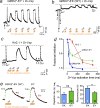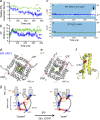Dynamic role of the tether helix in PIP2-dependent gating of a G protein-gated potassium channel
- PMID: 28720589
- PMCID: PMC5560777
- DOI: 10.1085/jgp.201711801
Dynamic role of the tether helix in PIP2-dependent gating of a G protein-gated potassium channel
Abstract
G protein-gated inwardly rectifying potassium (GIRK) channels control neuronal excitability in the brain and are implicated in several different neurological diseases. The anionic phospholipid phosphatidylinositol 4,5 bisphosphate (PIP2) is an essential cofactor for GIRK channel gating, but the precise mechanism by which PIP2 opens GIRK channels remains poorly understood. Previous structural studies have revealed several highly conserved, positively charged residues in the "tether helix" (C-linker) that interact with the negatively charged PIP2 However, these crystal structures of neuronal GIRK channels in complex with PIP2 provide only snapshots of PIP2's interaction with the channel and thus lack details about the gating transitions triggered by PIP2 binding. Here, our functional studies reveal that one of these conserved basic residues in GIRK2, Lys200 (6'K), supports a complex and dynamic interaction with PIP2 When Lys200 is mutated to an uncharged amino acid, it activates the channel by enhancing the interaction with PIP2 Atomistic molecular dynamic simulations of neuronal GIRK2 with the same 6' substitution reveal an open GIRK2 channel with PIP2 molecules adopting novel positions. This dynamic interaction with PIP2 may explain the intrinsic low open probability of GIRK channels and the mechanism underlying activation by G protein Gβγ subunits and ethanol.
© 2017 Lacin et al.
Figures






References
-
- Best R.B., Zhu X., Shim J., Lopes P.E., Mittal J., Feig M., and Mackerell A.D. Jr. 2012. Optimization of the additive CHARMM all-atom protein force field targeting improved sampling of the backbone φ, ψ and side-chain χ(1) and χ(2) dihedral angles. J. Chem. Theory Comput. 8:3257–3273. 10.1021/ct300400x - DOI - PMC - PubMed
Associated data
- Actions
- Actions
- Actions
Grants and funding
LinkOut - more resources
Full Text Sources
Other Literature Sources

